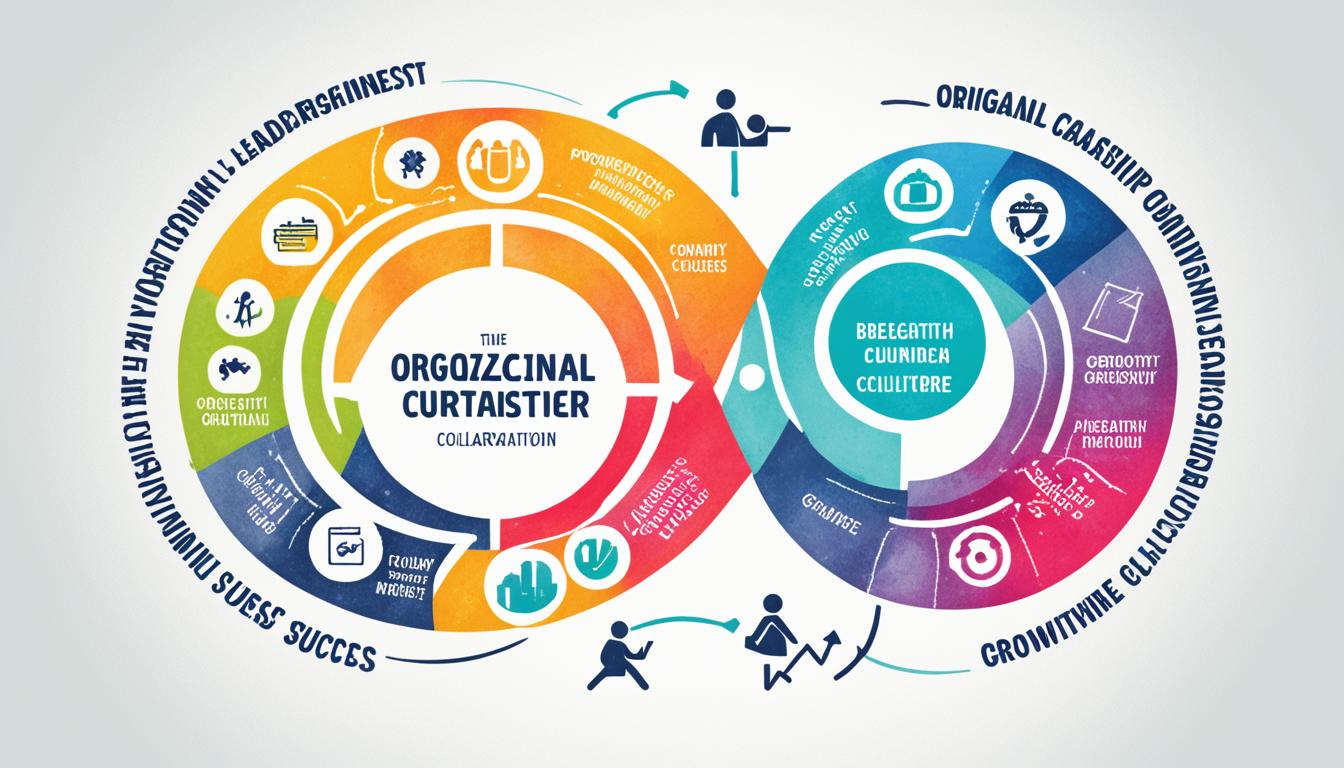Imagine walking into an office full of energy, where ideas are shared freely and mistakes are seen as chances to learn. This isn’t just a dream; it’s real for teams with strong leadership and culture. I’ve seen teams go from struggling to being full of innovation, thanks to great leadership.
Research by Murphy shows a clear truth: companies with a growth mindset do better in employee engagement and money-making. This is a big deal for all kinds of businesses. Startups and big companies alike see success when they focus on leadership and culture.
So, what does this mean for you? It doesn’t matter if you’re a top executive or just starting out. Knowing how leadership and culture connect is key. It’s about making a place where people do more than just get by. It’s where working together and learning from mistakes are the rule, not the exception.
As we look closer at how leadership and culture work together, remember: your leadership sets the tone for your company’s future. Let’s see how you can use this to build a workplace that draws in the best people and brings out the best in everyone.
Key Takeaways
- Cultures of Growth lead to higher employee engagement and financial success
- Leadership mindset directly influences organizational culture
- Collaboration and learning from mistakes foster stronger bottom lines
- 70% of employee engagement variance is linked to direct managers
- 77% of job seekers research company culture before applying
- Leaders’ actions aligning with words increase employee engagement by 55%
- Toxic company culture is the top reason employees leave jobs
Understanding the Connection Between Leadership and Culture
Leadership and culture go hand in hand. A leader’s mindset sets the tone in the workplace. This affects how motivated employees are and how well they perform. Studies reveal that more than 70% of U.S. workers feel driven to excel when they connect with their company’s culture and values.
Defining Leadership Mindset
A leader’s mindset is about strategic thinking, emotional smarts, and sticking to company values. Leaders who focus on these areas spend more time with their teams. This builds a positive work atmosphere and boosts success.

The Impact of Leadership on Organizational Culture
Great leaders shape the company culture with their actions and words. When leaders explain how employees’ work matters, engagement goes up by 29%. And, the quality of work improves by 200%.
Being open about the company’s goals also leads to a 87% increase in top-notch work.
Key Elements of a Positive Company Culture
A positive company culture needs a few key things:
- Connecting employees to the organization’s purpose
- Providing growth opportunities
- Showing appreciation for efforts
- Promoting wellbeing
- Empowering innovation
Companies that focus on these people-focused strategies are 1.4 times more likely to be seen as great places to work. By letting employees lead and innovate, companies see a big jump in feeling of opportunity and a 78% increase in engagement.
“The way a team plays as a whole determines its success. You may have the greatest bunch of individual stars in the world, but if they don’t play together, the club won’t be worth a dime.”
The Importance of Emotional Intelligence in Leadership
Emotional intelligence (EQ) is key to being a successful leader. Studies show that 71% of employers look for EQ more than technical skills in job seekers. This shows how important EQ is in leading teams and managing change.

Leaders with high EQ do well in many areas. They make smart choices, own their actions, and think before they act. This skill helps them lead better and benefits their teams.
A study by TalentSmart found EQ is the top predictor of success at work. This proves EQ’s role in leading change and improving team communication.
“Empathy is the number one leadership skill, with leaders who master it performing over 40% higher in coaching, engaging others, and decision-making.” – Global leadership development firm DDI
Leaders with high EQ make workplaces better. A survey by the Society for Human Resource Management showed that 72% of workers value being treated with respect. This shows EQ’s effect on keeping employees happy and on the job.
To get better at EQ, leaders should work on emotional agility. This means noticing patterns, naming feelings, accepting them, and acting on values, not emotions. By improving these skills, leaders can handle challenges better and motivate their teams to do well.
Cultivating a Growth Mindset in Leadership
Leaders shape the culture of their organizations. A growth mindset in leadership changes how teams face challenges and makes the workplace better. This belief that skills can be developed helps with employee engagement and building teams.
Benefits of a Growth Mindset Culture
Companies with a growth mindset culture gain a lot. They see a 54% jump in employee engagement. This mindset leads to more innovation, resilience, and constant improvement at every level.
| Benefit | Impact |
|---|---|
| Open Communication | 22% increase in productivity |
| Recognition of Achievements | 33% higher employee retention |
| Learning Opportunities | 76% increase in employee empowerment |
Overcoming Common Leadership Mind Traps
Leaders often struggle with mental barriers. These include fear of failure, avoiding feedback, and not liking change. It’s key to get past these to build a culture of learning and innovation.

Strategies for Developing a Growth Mindset
Creating a growth mindset takes effort. Leaders should see challenges as chances to grow, encourage taking risks, and keep learning themselves. Adding growth mindset ideas to reviews can increase motivation by 27%. Focusing on progress and helping employees grow makes teams stronger and the workforce more engaged.
“The hallmark of successful people is that they are always stretching themselves to learn new things.” – Carol Dweck
Leadership Mindset and Organizational Culture: A Symbiotic Relationship
The way leaders think and the culture of an organization work together to shape the workplace. Leaders who think strategically are key to creating a place where people grow. These leaders make their teams more innovative and creative by 47%.
A culture that values growth makes everyone want to improve and keep learning. This fits well with leadership that inspires people to do more than expected. By using these ideas in how they manage talent, companies can make everyone in the organization think about growing together.
Companies like Microsoft and HP have seen better employee engagement and new ideas because of this approach. This shows how important strategic thinking is for leaders. It helps them make changes that lead to success over time. By focusing on growth and learning, companies can keep more employees and make them happier by 45%.
FAQ
What is the connection between leadership mindset and organizational culture?
Leadership mindset and organizational culture are closely connected. Leaders set and maintain company values and policies. This shapes the company culture through their relationship with employees.
What are the key elements of a positive company culture?
Six key elements, or Talent Magnets, make a culture positive and thriving. These are Purpose, Opportunity, Success, Appreciation, Wellbeing, and Leadership. They create a sense of connection, belonging, and fulfillment, helping to keep top talent.
Why is emotional intelligence (EQ) important for leaders?
Emotional intelligence (EQ) is key for leaders. It means understanding and managing one’s and others’ emotions. Leaders with high EQ make smart choices, take responsibility, and respond well under pressure.
What are the benefits of a growth mindset culture?
A growth mindset culture brings many benefits. It builds trust, strengthens commitment, and encourages taking risks.
How can organizations create a collective growth mindset?
To create a collective growth mindset, teach and encourage continuous learning and development. Make sure these values are part of your talent systems and processes. Ensure top leaders are engaged and clear about the culture change goals.
Source Links
- https://www.forbes.com/sites/rodgerdeanduncan/2024/04/29/how-organizational-culture-impacts-your-performace/

- https://executive.berkeley.edu/thought-leadership/blog/leadership-mindset

- https://arbinger.com/blog/from-the-top-down-how-leadership-affects-organizational-culture

- https://online.hbs.edu/blog/post/organizational-culture-and-leadership

- https://www.octanner.com/articles/how-does-leadership-influence-organizational-culture

- https://www.ddiworld.com/blog/leadership-culture

- https://online.hbs.edu/blog/post/emotional-intelligence-in-leadership

- https://www.dhrglobal.com/insights/the-importance-of-emotional-intelligence-in-leadership/

- https://www.linkedin.com/pulse/importance-emotional-intelligence-leadership-calm-com-0bwxc

- https://online.ewu.edu/degrees/business/ms-organizational-leadership/cultivating-a-growth-mindset-culture/

- https://blog.culturewise.com/cultivating-a-growth-mindset-company-culture

- https://www.blairkennergroup.com/cultivating-growth-mindset-culture/

- https://skylineg.com/resources/blog/organizational-culture

- https://medium.com/@drthediasamara/the-symbiotic-relationship-between-organization-and-mindsets-83a46e41b2d7

- https://www.linkedin.com/pulse/leaders-teams-symbiotic-relationship-bill-woodson


